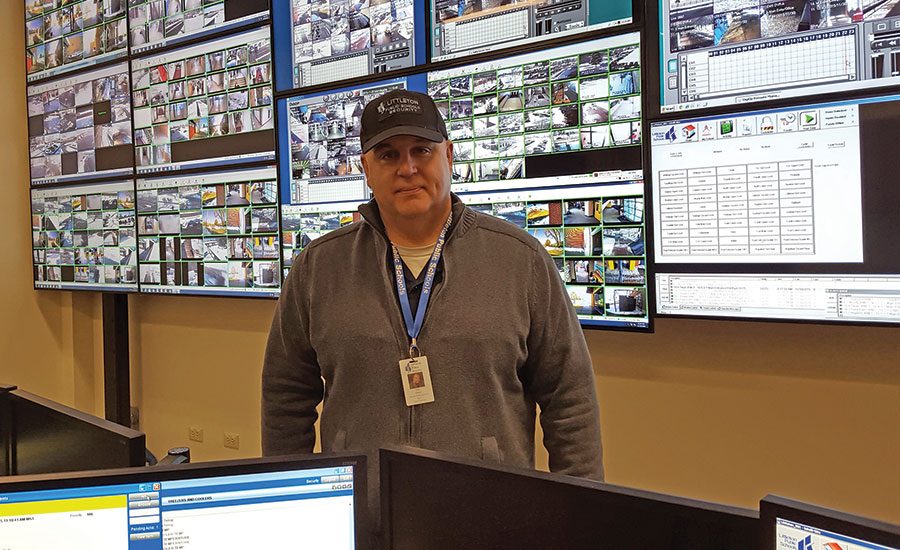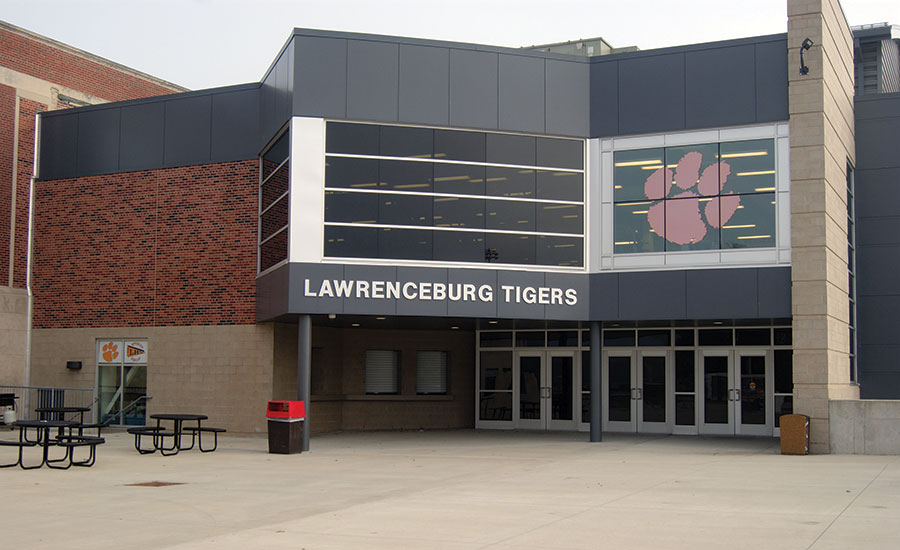Nailing Down the Right Lockdown Procedure for School Security
Schools contemplate the options amidst their overall security mix to keep students and staff safe.

The Lawrenceburg (Indiana) Community School Corp., which has 2,000 students and 250 staff, and four school buildings, an administrative office and a fifth alternative school that’s housed in the maintenance facility, tries to find a balance between welcoming students and visitors while keeping security paramount. Photo courtesy of The Lawrenceburg Community School Corp.

Kenneth Trump, president of National School Safety and Security Services, has heard about “ridiculous” measures like bulletproof backpacks for students, bulletproof whiteboards for classrooms, and training that teaches students and staff to attack and throw objects at armed gunmen. “People are looking for the ‘Wow!’ but now thinking about the ‘How!’ in terms of the inability and unreasonableness of implementing these and other ideas,” he says. Photo courtesy of Ken Trump

At Littleton (Colorado) Public Schools, which endured the Arapahoe High School shootings in 2013 and is just down the road from Columbine, mental health issues rank as the top security concern for Guy Grace, director of security and emergency preparedness. “We are on duty 24-7, even if it’s off school grounds,” given the spread of bullying to social media, Grace says. “That’s what keeps me up at night.” Sometimes literally, he adds, because “alerts come in at all hours. You have to respond to them. You hope you can hear about them during the school day, but often you don’t.” Photo courtesy of Guy Grace



It didn’t happen in a K-12 setting, but the Las Vegas massacre no doubt rekindled the fears of school security personnel dating back to Sandy Hook Elementary in 2012 and all the way to Columbine High School in 1999.
As schools and districts contemplate the right mix of equipment, technology, training and policies and procedures to keep students and staff safe, the debate churns over how they should institute lockdown procedures for their buildings during an active shooter event.
High-profile incidents drive a search to do something new and different to bolster security, but the conversation that follows often seems aimed at addressing emotional security needs of parents, educators and the broader society, says Kenneth Trump, president of National School Safety and Security Services.
Trump has heard about “ridiculous” measures like bulletproof backpacks for students, bulletproof whiteboards for classrooms and training that teaches students and staff to attack and throw objects at armed gunmen. “People are looking for the ‘Wow!’ but now thinking about the ‘How!’ in terms of the inability and unreasonableness of implementing these and other ideas,” he says.
Such “knee-jerk” moves do little to increase actual security and may create a false sense of security, Trump says. What administrators and security personnel should be doing is focusing on “proven security and preparedness procedures” and proactive communications to get the word out to their school community. Although administrators are increasingly conscious of their high-profile presence on social media, he says, “Many of the security and preparedness measures schools really need to do to improve security are less flashy and fad-driven, and sometimes more discreet or even invisible.”
At Littleton (Colorado) Public Schools, which endured the Arapahoe High School shootings in 2013 and is just down the road from Columbine, mental health issues rank as the top security concern for Guy Grace, director of security and emergency preparedness.
“We are on duty 24/7, even if it’s off school grounds,” given the spread of bullying to social media, Grace says. “That’s what keeps me up at night.” Sometimes literally, he adds, because “alerts come in at all hours. You have to respond to them. You hope you can hear about them during the school day, but often you don’t.”
Lawrenceburg (Indiana) Community School Corp., which has 2,000 students and 250 staff, and four school buildings, an administrative office and a fifth alternative school that’s housed in the maintenance facility, tries to find a balance between welcoming students and visitors while keeping security paramount, says Karl Galey, superintendent.
“Student possession of weapons or devices that could lead to an active intruder in the building is the most pressing threat,” he says. “You don’t want to put metal detectors at every door, but kids are walking in with their bookbags and you don’t know what’s in them. That’s the biggest fear.”
Severe weather events and the best ways to communicate during a crisis of any sort are top of mind for Mark Tollett, facilities manager at Pinecrest Academy, a pre-K-12 Catholic school in Cumming, Ga. With 800 students spread across three separate buildings on a 68-acre campus, getting the word out during a weather event or other crisis presents challenges.
“You have so many different ways you can tell the community what’s happening in your school,” such as Twitter and other social media, he says. “We’ve found that on an internal level, radios work really well.” Each school building has one, with different channels used for emergency and non-emergency announcements.
Physical and People Focus
While schools can certainly invest in technology devices and services, not all have the budgets necessary to purchase them and, more importantly, such equipment does not always apply well to a K-12 setting and its climate, culture and community relations, Trump says.
“In most cases, the answer is ‘no’ to both questions” about budget and culture, he says. “We are seeing far too many school districts throw thousands of dollars in security equipment such as cameras based on one-time grants or other budget allocations, only to have no budgets for maintenance and replacement in the months and years ahead. The result: Cameras that are not functioning, not being repaired and presenting a false sense of security, along with a potential liability risk, to school districts.”
Certain security equipment makes perfect sense in the school environment, such as main entrance surveillance at elementary schools from a single, one-person view buzzer-camera-intercom front doorway, as well as a camera or two that show the entire front door area to ensure that no one “piggybacks” behind legitimate visitors, Trump says.
Districts that are building or renovating schools should pay attention to CPTED (Crime Prevention Through Environmental Design) concepts, such as configuring entrances in a way that funnel visitors through the office, to enhance hallway supervision with improved line-of-sight, to putting restroom sinks in a common area on the outskirts of the bathrooms so adults can better supervise children and prevent bullying, Trump says.
Littleton Public Schools, which serves more than 15,000 students across 28 schools, has deployed not only access control and video surveillance but also audio monitoring with equipment from Louroe Electronics. The microphones, deployed across the district last spring, were compatible with existing camera systems from 3xLOGIC to boost accountability, documentation and verification, Grace says.
“When looking at events that cause disruptions to the schools, especially at the elementary level, occasionally we can have parents or visitors that can become very irate in the front offices,” he says. “If a guest starts to yell and scream and the school needs help, prompting and administrator to hit the ‘duress’ button, we can now see and hear what is going on.” Not only seeing but also hearing what’s going on gives Grace and his staff the ability to begin formulating a response, he adds.
In addition to its school-by-school radios, Pinecrest Academy has installed a ShoreTel voiceover IP phone system that allows safety and security staff to create virtual phone numbers for the security staff such that if someone calls that number it rings any device they might have, Tollett says. And the school is testing a multi-platform system called Bright Arrow that will enable e-mails, tests or voice recordings to be blasted out to the entire school community.
Lawrenceburg CSC has contracted with Response Technologies for wireless panic buttons in front offices as a way to mitigate threats, Galey says. These alert city, county and state law enforcement directly if activated as well as internal school radios. “That reduces the response time,” he says. “If one school building goes into lockdown, they hear it at the other buildings and they can go into lockdown immediately.”
The district has been working with Stanley to install a schoolwide door-locking system (currently in one building) that 10 staff members ranging from teachers, to the cafeteria manager, to the head custodian can active schoolwide. “If they press that button, it automatically locks all classroom doors and doors throughout the interior of the building,” Galey says.
For all the value provided by new equipment, however, building relationships with students is the most surefire way to mitigate threats. “If students feel comfortable and safe speaking with you, they’re going to share information overheard,” he says. “That’s the first thing, trying to build those relationships.”
For students and staff to feel comfortable during an emergency, schools need to repeatedly practice drills, Tollett says. “We’ve tried to look at, what’s really practical?’ ” he says. “Do you send the kids out into the parking lot for a fire drill, when you have the fire trucks coming in on the parking lot? You need to find a place they can go. … Drilling is about getting kids comfortable and getting teachers comfortable so they understand what they need to do – so that if something does happen, it’s kind of like, ‘Alright, we’re doing the drill.’ ”
Schools need to pay attention to the softer side of security, Trump says. “It’s easy to point to more cameras or additional police at a school, neither of which on their own are bad things, but it’s harder to point to adults building relationships with kids, improved counseling and mental health support, regular planning and cross-training with first responders, and diversified lockdown, evacuation, fire and other drills, and proactive communications strategy with parents and the community – all of which truly make schools safer,” he says.
Superintendents, principals and school boards should invest at least as much in people and planning as they do in equipment and technology, Trump believes. “Too often, we see well-intentioned school leaders who will be quick to drop some dollars for physical security equipment they can point to when talking with parents, but they are much more guarded in releasing time for training school staff, diversifying their lockdown or evacuation drills, and doing meaningful, detailed planning with their first responders,” he says.
Getting Down to Lockdowns
Instead of attacking active shooters, districts should focus on lockdown procedures, which have been viewed as a best practice dating to Columbine, Trump says. “School administrators and safety personnel can diversity those drills by doing them during lunch periods, class changes, or upon school arrival,” he says. “School and safety leaders need to focus on the human side of school safety, not just [take] a hardware or equipment approach.”
Littleton had started implementing an options-based lockdown program in 2013 – shelter, evade, defend, care – that Grace believes prevented a mass casualty event that December, when only one tragic death occurred. The training for faculty and students covered technology aspects like the district’s mass notification system and how it works, how and where to hide, and how to defend themselves.
“It’s ever-evolving,” he says. “In our school district, we’ve obviously been in an active shooter incident, and we’re applying these lessons learned from what we experienced and what others have experienced. … We have to make sure that our staff and our students are ready to respond to these situations.”
The shelter-evade-defend-care sequence, a variation on the “run-hide-fight” used in other districts, is recommended by both the National Association of School Resources Officers and the National Association of School Psychologists, Grace notes. “The options-based protocol is designed to empower staff and students to respond to violent situations,” he says.
The newly installed microphones from Louroe enhance real-time situational awareness in these scenarios, and staff and students can use lockdown buttons mounted in strategic locations where people could shelter such as an office. The buttons also trigger mass notification protocols, Grace says.
The district does not do surprise lockdown procedures because that only instills fear and panic, he believes, which is not conducive to a productive learning environment. “There’s no attaboys in an active shooter event,” Grace says. “But if you can empower people to use their senses, use the things you show them, I believe they can use their abilities to get themselves and their students out of danger. It’s about giving them ways to think about multiple tactics they can utilize, but also improve because no two incidents are going to be the same.”
Pinecrest Academy has developed a “Guide to Emergency Preparedness” that’s been distributed to all teachers and staff that covers all the drills the school buildings might undertake, including lockdown procedures, Tollett says. They have partnered with the county fire and sheriff’s departments as well as the Georgia Emergency Management Agency, which did a full site assessment two years ago and helped Pinecrest develop lockdown procedures.
“If we sense that there’s trouble, that a lockdown event might occur, it’s something we can [broadcast] across the intercom,” he says. “Every classroom gets the alert. The teacher goes and locks the door. Kids go into the lockdown position. We pick the best wall for the kids to be on. People who are in place are safe.”
Pinecrest met with the local sheriff’s department and the Georgia Emergency Management and Homeland Security Agency (GEMA) about how best to communicate with 911 in the event of a lockdown and talked them through the department’s procedures upon arriving on campus, Tollett says. “We just want to continuously have that presence with these organizations because they deal with [emergencies] day-in and day-out,” he says.
Lawrenceburg uses the ALICE (alert, lockdown, inform, counter, evacuate) method of securing the building, providing training to staff and students a few times per year led by the school resource officer, who is a trained police officer, and testing the panic button during lockdown drills, Galey says.
“We’ve provided classroom training as well as situational reenactment,” he says “We want to empower them to be able to react to situations as they encounter them. There’s not necessarily always going to be one solution fits all to every situation. With ALICE, you’re using the information you have at hand to react.”
Lawrenceburg has instituted two options for lockdowns: a perimeter lockdown in reaction to an emergency in the wider community, during which no one is allowed in or out, but the building otherwise functions normally; and the full lockdown, during which they enact the ALICE protocol, Galey says. “If an active intruder is too close, you’re going to have to lock down,” he says. “Based on the information you have, you react.”
Looking for a reprint of this article?
From high-res PDFs to custom plaques, order your copy today!








